Nursing Essay: Physiological Basis of Wound Healing and Antibiotics
VerifiedAdded on 2020/10/05
|7
|1656
|203
Essay
AI Summary
This nursing essay delves into the complexities of wound healing, examining the physiological basis for wound appearance, the sources of wound contamination, and the rationale behind antibiotic choices, specifically dicloxacillin. The essay explores the four stages of wound healing: hemostasis, inflammation, proliferation, and maturation, while also discussing the adverse effects of antibiotics and the importance of completing the full course of treatment. It analyzes the case of Mary, who sustained a laceration from a broken glass bottle, to illustrate the practical application of these concepts. The essay highlights the significance of addressing purulent discharge, potential endogenous and exogenous sources of infection, and the role of antibiotics in preventing complications and promoting healing. The references cited provide further insights into wound care and management.
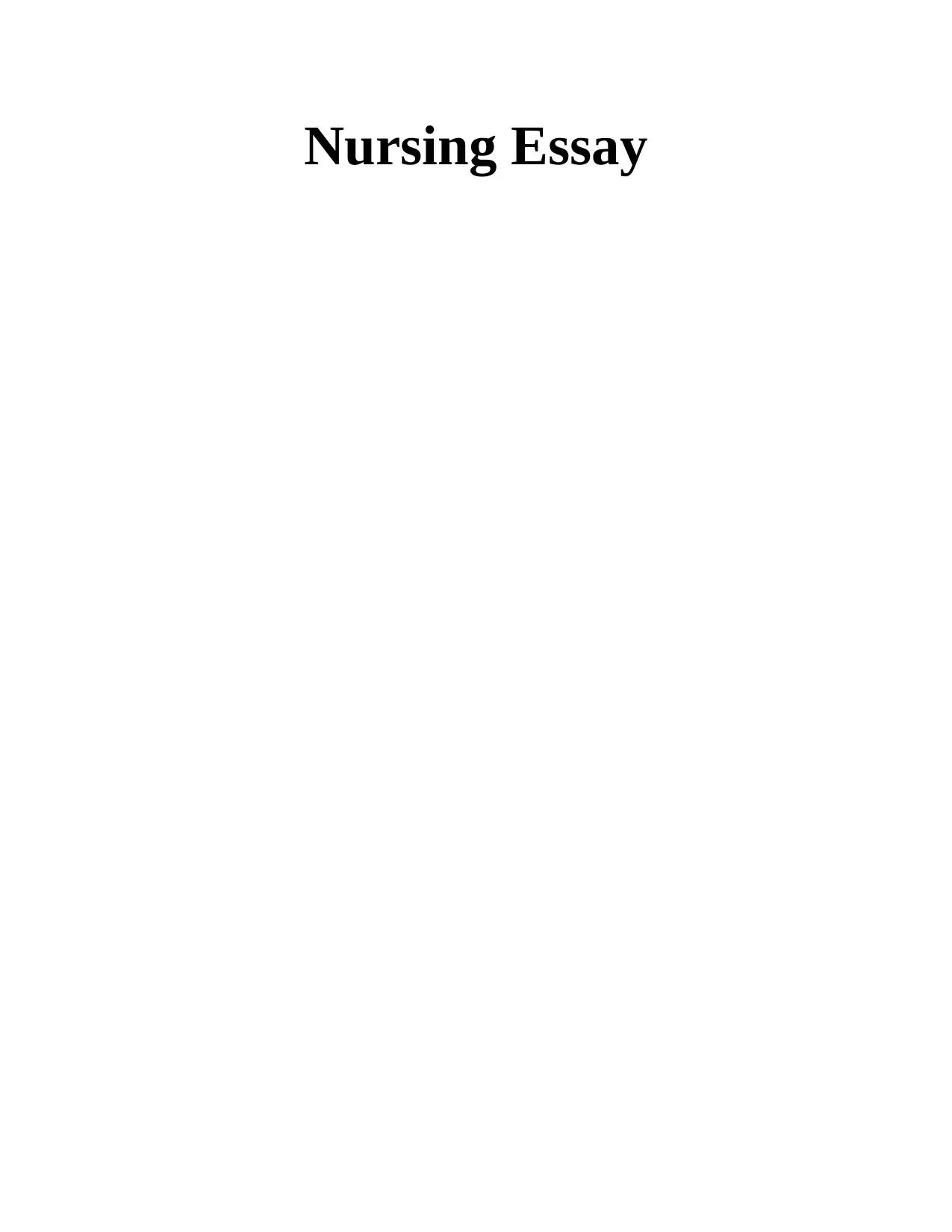
Nursing Essay
Paraphrase This Document
Need a fresh take? Get an instant paraphrase of this document with our AI Paraphraser
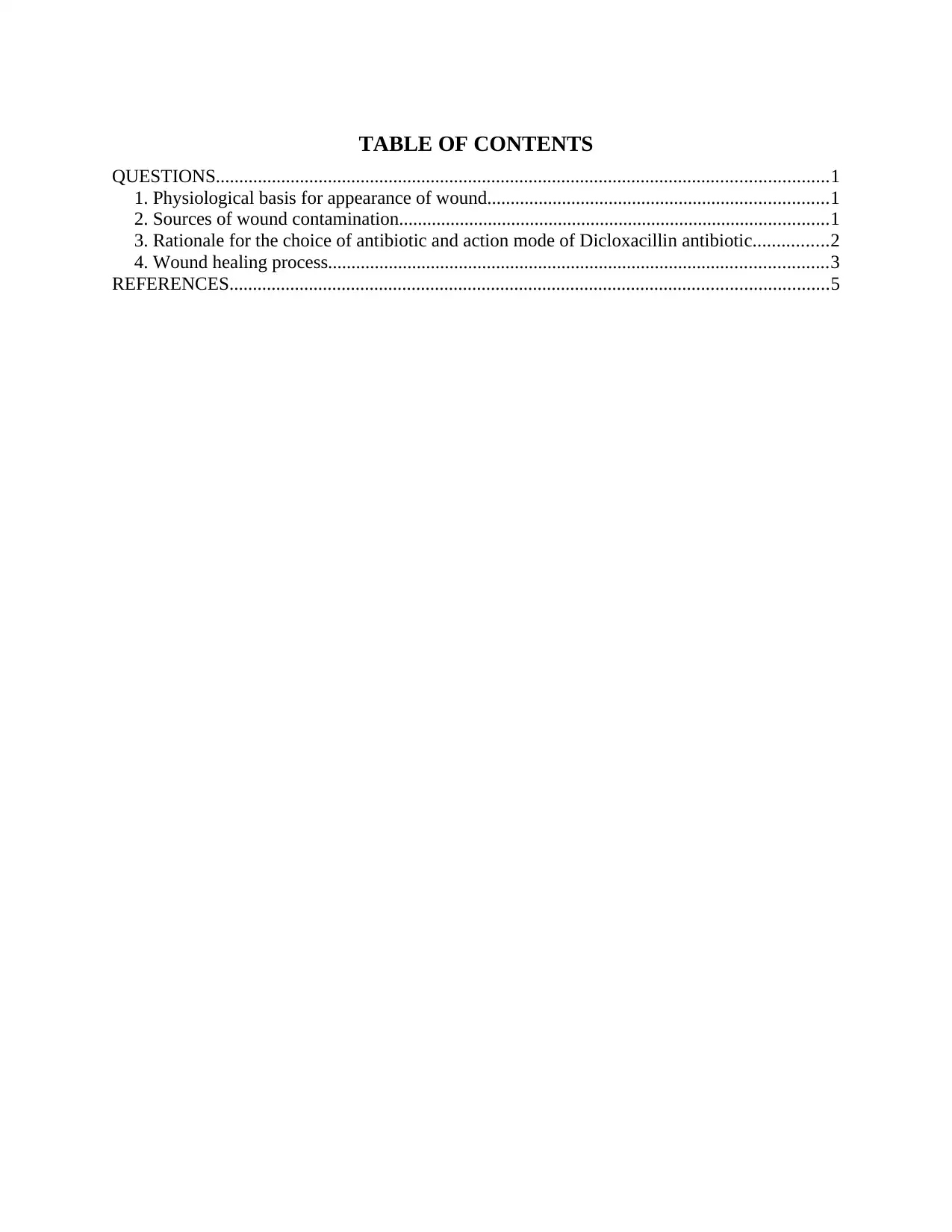
TABLE OF CONTENTS
QUESTIONS...................................................................................................................................1
1. Physiological basis for appearance of wound.........................................................................1
2. Sources of wound contamination............................................................................................1
3. Rationale for the choice of antibiotic and action mode of Dicloxacillin antibiotic................2
4. Wound healing process...........................................................................................................3
REFERENCES................................................................................................................................5
QUESTIONS...................................................................................................................................1
1. Physiological basis for appearance of wound.........................................................................1
2. Sources of wound contamination............................................................................................1
3. Rationale for the choice of antibiotic and action mode of Dicloxacillin antibiotic................2
4. Wound healing process...........................................................................................................3
REFERENCES................................................................................................................................5
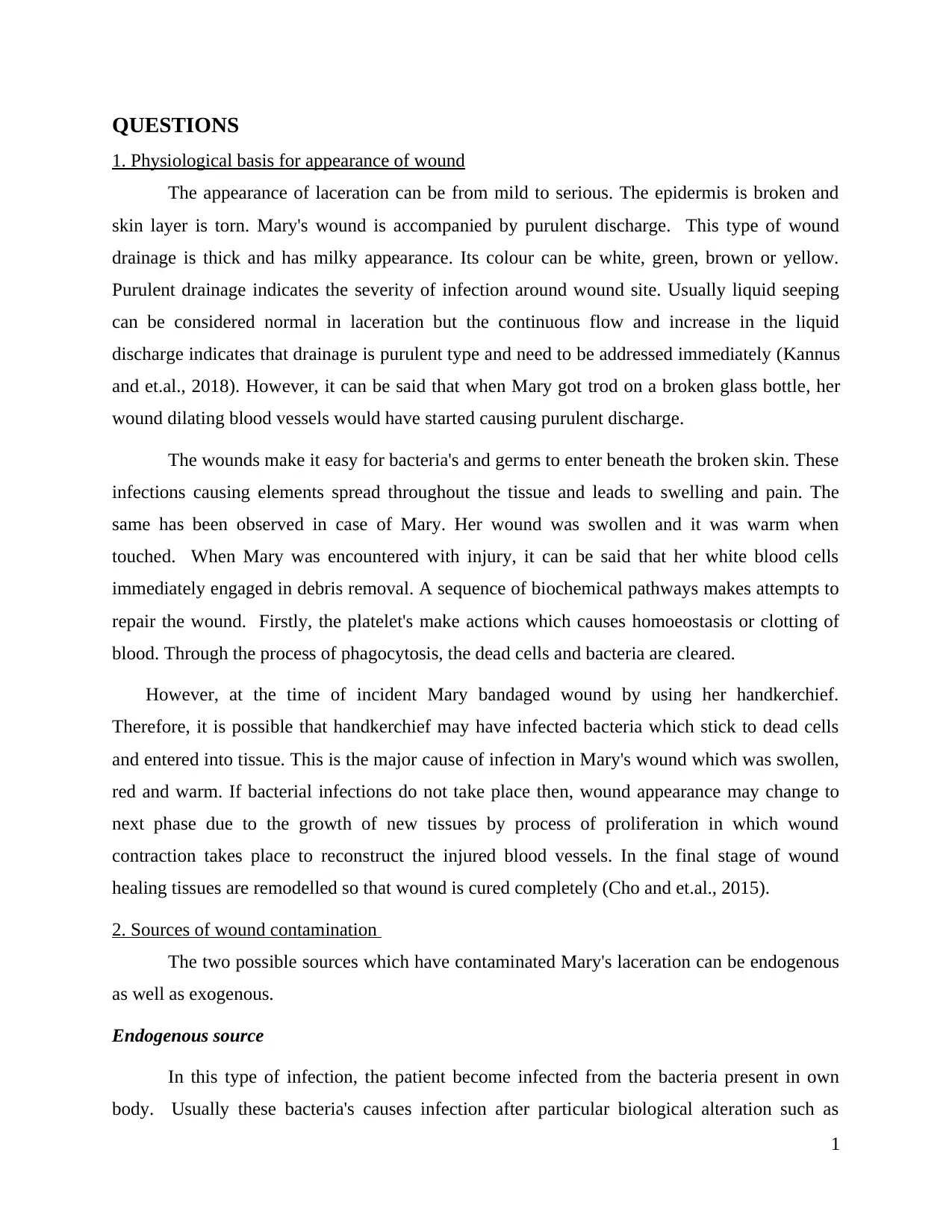
QUESTIONS
1. Physiological basis for appearance of wound
The appearance of laceration can be from mild to serious. The epidermis is broken and
skin layer is torn. Mary's wound is accompanied by purulent discharge. This type of wound
drainage is thick and has milky appearance. Its colour can be white, green, brown or yellow.
Purulent drainage indicates the severity of infection around wound site. Usually liquid seeping
can be considered normal in laceration but the continuous flow and increase in the liquid
discharge indicates that drainage is purulent type and need to be addressed immediately (Kannus
and et.al., 2018). However, it can be said that when Mary got trod on a broken glass bottle, her
wound dilating blood vessels would have started causing purulent discharge.
The wounds make it easy for bacteria's and germs to enter beneath the broken skin. These
infections causing elements spread throughout the tissue and leads to swelling and pain. The
same has been observed in case of Mary. Her wound was swollen and it was warm when
touched. When Mary was encountered with injury, it can be said that her white blood cells
immediately engaged in debris removal. A sequence of biochemical pathways makes attempts to
repair the wound. Firstly, the platelet's make actions which causes homoeostasis or clotting of
blood. Through the process of phagocytosis, the dead cells and bacteria are cleared.
However, at the time of incident Mary bandaged wound by using her handkerchief.
Therefore, it is possible that handkerchief may have infected bacteria which stick to dead cells
and entered into tissue. This is the major cause of infection in Mary's wound which was swollen,
red and warm. If bacterial infections do not take place then, wound appearance may change to
next phase due to the growth of new tissues by process of proliferation in which wound
contraction takes place to reconstruct the injured blood vessels. In the final stage of wound
healing tissues are remodelled so that wound is cured completely (Cho and et.al., 2015).
2. Sources of wound contamination
The two possible sources which have contaminated Mary's laceration can be endogenous
as well as exogenous.
Endogenous source
In this type of infection, the patient become infected from the bacteria present in own
body. Usually these bacteria's causes infection after particular biological alteration such as
1
1. Physiological basis for appearance of wound
The appearance of laceration can be from mild to serious. The epidermis is broken and
skin layer is torn. Mary's wound is accompanied by purulent discharge. This type of wound
drainage is thick and has milky appearance. Its colour can be white, green, brown or yellow.
Purulent drainage indicates the severity of infection around wound site. Usually liquid seeping
can be considered normal in laceration but the continuous flow and increase in the liquid
discharge indicates that drainage is purulent type and need to be addressed immediately (Kannus
and et.al., 2018). However, it can be said that when Mary got trod on a broken glass bottle, her
wound dilating blood vessels would have started causing purulent discharge.
The wounds make it easy for bacteria's and germs to enter beneath the broken skin. These
infections causing elements spread throughout the tissue and leads to swelling and pain. The
same has been observed in case of Mary. Her wound was swollen and it was warm when
touched. When Mary was encountered with injury, it can be said that her white blood cells
immediately engaged in debris removal. A sequence of biochemical pathways makes attempts to
repair the wound. Firstly, the platelet's make actions which causes homoeostasis or clotting of
blood. Through the process of phagocytosis, the dead cells and bacteria are cleared.
However, at the time of incident Mary bandaged wound by using her handkerchief.
Therefore, it is possible that handkerchief may have infected bacteria which stick to dead cells
and entered into tissue. This is the major cause of infection in Mary's wound which was swollen,
red and warm. If bacterial infections do not take place then, wound appearance may change to
next phase due to the growth of new tissues by process of proliferation in which wound
contraction takes place to reconstruct the injured blood vessels. In the final stage of wound
healing tissues are remodelled so that wound is cured completely (Cho and et.al., 2015).
2. Sources of wound contamination
The two possible sources which have contaminated Mary's laceration can be endogenous
as well as exogenous.
Endogenous source
In this type of infection, the patient become infected from the bacteria present in own
body. Usually these bacteria's causes infection after particular biological alteration such as
1
⊘ This is a preview!⊘
Do you want full access?
Subscribe today to unlock all pages.

Trusted by 1+ million students worldwide
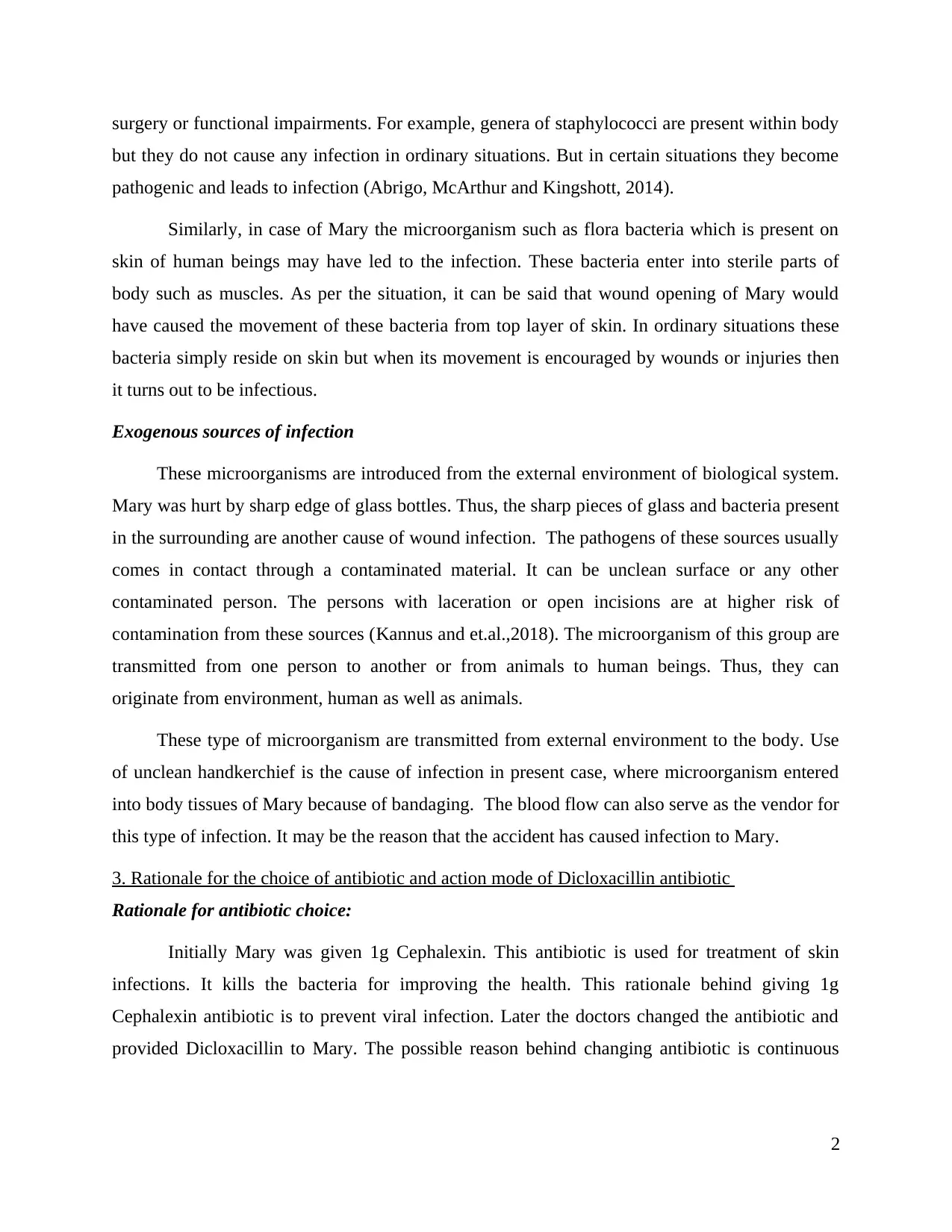
surgery or functional impairments. For example, genera of staphylococci are present within body
but they do not cause any infection in ordinary situations. But in certain situations they become
pathogenic and leads to infection (Abrigo, McArthur and Kingshott, 2014).
Similarly, in case of Mary the microorganism such as flora bacteria which is present on
skin of human beings may have led to the infection. These bacteria enter into sterile parts of
body such as muscles. As per the situation, it can be said that wound opening of Mary would
have caused the movement of these bacteria from top layer of skin. In ordinary situations these
bacteria simply reside on skin but when its movement is encouraged by wounds or injuries then
it turns out to be infectious.
Exogenous sources of infection
These microorganisms are introduced from the external environment of biological system.
Mary was hurt by sharp edge of glass bottles. Thus, the sharp pieces of glass and bacteria present
in the surrounding are another cause of wound infection. The pathogens of these sources usually
comes in contact through a contaminated material. It can be unclean surface or any other
contaminated person. The persons with laceration or open incisions are at higher risk of
contamination from these sources (Kannus and et.al.,2018). The microorganism of this group are
transmitted from one person to another or from animals to human beings. Thus, they can
originate from environment, human as well as animals.
These type of microorganism are transmitted from external environment to the body. Use
of unclean handkerchief is the cause of infection in present case, where microorganism entered
into body tissues of Mary because of bandaging. The blood flow can also serve as the vendor for
this type of infection. It may be the reason that the accident has caused infection to Mary.
3. Rationale for the choice of antibiotic and action mode of Dicloxacillin antibiotic
Rationale for antibiotic choice:
Initially Mary was given 1g Cephalexin. This antibiotic is used for treatment of skin
infections. It kills the bacteria for improving the health. This rationale behind giving 1g
Cephalexin antibiotic is to prevent viral infection. Later the doctors changed the antibiotic and
provided Dicloxacillin to Mary. The possible reason behind changing antibiotic is continuous
2
but they do not cause any infection in ordinary situations. But in certain situations they become
pathogenic and leads to infection (Abrigo, McArthur and Kingshott, 2014).
Similarly, in case of Mary the microorganism such as flora bacteria which is present on
skin of human beings may have led to the infection. These bacteria enter into sterile parts of
body such as muscles. As per the situation, it can be said that wound opening of Mary would
have caused the movement of these bacteria from top layer of skin. In ordinary situations these
bacteria simply reside on skin but when its movement is encouraged by wounds or injuries then
it turns out to be infectious.
Exogenous sources of infection
These microorganisms are introduced from the external environment of biological system.
Mary was hurt by sharp edge of glass bottles. Thus, the sharp pieces of glass and bacteria present
in the surrounding are another cause of wound infection. The pathogens of these sources usually
comes in contact through a contaminated material. It can be unclean surface or any other
contaminated person. The persons with laceration or open incisions are at higher risk of
contamination from these sources (Kannus and et.al.,2018). The microorganism of this group are
transmitted from one person to another or from animals to human beings. Thus, they can
originate from environment, human as well as animals.
These type of microorganism are transmitted from external environment to the body. Use
of unclean handkerchief is the cause of infection in present case, where microorganism entered
into body tissues of Mary because of bandaging. The blood flow can also serve as the vendor for
this type of infection. It may be the reason that the accident has caused infection to Mary.
3. Rationale for the choice of antibiotic and action mode of Dicloxacillin antibiotic
Rationale for antibiotic choice:
Initially Mary was given 1g Cephalexin. This antibiotic is used for treatment of skin
infections. It kills the bacteria for improving the health. This rationale behind giving 1g
Cephalexin antibiotic is to prevent viral infection. Later the doctors changed the antibiotic and
provided Dicloxacillin to Mary. The possible reason behind changing antibiotic is continuous
2
Paraphrase This Document
Need a fresh take? Get an instant paraphrase of this document with our AI Paraphraser
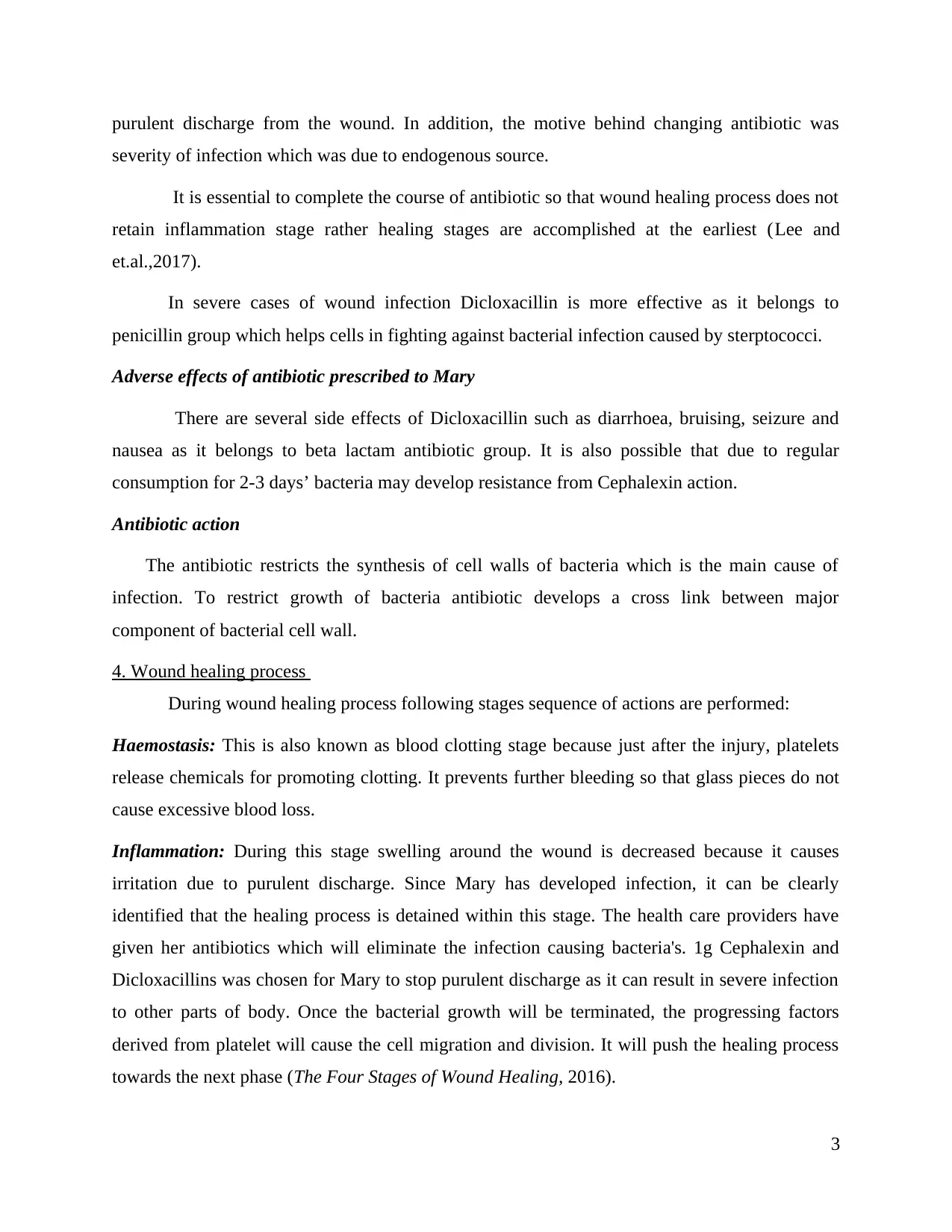
purulent discharge from the wound. In addition, the motive behind changing antibiotic was
severity of infection which was due to endogenous source.
It is essential to complete the course of antibiotic so that wound healing process does not
retain inflammation stage rather healing stages are accomplished at the earliest (Lee and
et.al.,2017).
In severe cases of wound infection Dicloxacillin is more effective as it belongs to
penicillin group which helps cells in fighting against bacterial infection caused by sterptococci.
Adverse effects of antibiotic prescribed to Mary
There are several side effects of Dicloxacillin such as diarrhoea, bruising, seizure and
nausea as it belongs to beta lactam antibiotic group. It is also possible that due to regular
consumption for 2-3 days’ bacteria may develop resistance from Cephalexin action.
Antibiotic action
The antibiotic restricts the synthesis of cell walls of bacteria which is the main cause of
infection. To restrict growth of bacteria antibiotic develops a cross link between major
component of bacterial cell wall.
4. Wound healing process
During wound healing process following stages sequence of actions are performed:
Haemostasis: This is also known as blood clotting stage because just after the injury, platelets
release chemicals for promoting clotting. It prevents further bleeding so that glass pieces do not
cause excessive blood loss.
Inflammation: During this stage swelling around the wound is decreased because it causes
irritation due to purulent discharge. Since Mary has developed infection, it can be clearly
identified that the healing process is detained within this stage. The health care providers have
given her antibiotics which will eliminate the infection causing bacteria's. 1g Cephalexin and
Dicloxacillins was chosen for Mary to stop purulent discharge as it can result in severe infection
to other parts of body. Once the bacterial growth will be terminated, the progressing factors
derived from platelet will cause the cell migration and division. It will push the healing process
towards the next phase (The Four Stages of Wound Healing, 2016).
3
severity of infection which was due to endogenous source.
It is essential to complete the course of antibiotic so that wound healing process does not
retain inflammation stage rather healing stages are accomplished at the earliest (Lee and
et.al.,2017).
In severe cases of wound infection Dicloxacillin is more effective as it belongs to
penicillin group which helps cells in fighting against bacterial infection caused by sterptococci.
Adverse effects of antibiotic prescribed to Mary
There are several side effects of Dicloxacillin such as diarrhoea, bruising, seizure and
nausea as it belongs to beta lactam antibiotic group. It is also possible that due to regular
consumption for 2-3 days’ bacteria may develop resistance from Cephalexin action.
Antibiotic action
The antibiotic restricts the synthesis of cell walls of bacteria which is the main cause of
infection. To restrict growth of bacteria antibiotic develops a cross link between major
component of bacterial cell wall.
4. Wound healing process
During wound healing process following stages sequence of actions are performed:
Haemostasis: This is also known as blood clotting stage because just after the injury, platelets
release chemicals for promoting clotting. It prevents further bleeding so that glass pieces do not
cause excessive blood loss.
Inflammation: During this stage swelling around the wound is decreased because it causes
irritation due to purulent discharge. Since Mary has developed infection, it can be clearly
identified that the healing process is detained within this stage. The health care providers have
given her antibiotics which will eliminate the infection causing bacteria's. 1g Cephalexin and
Dicloxacillins was chosen for Mary to stop purulent discharge as it can result in severe infection
to other parts of body. Once the bacterial growth will be terminated, the progressing factors
derived from platelet will cause the cell migration and division. It will push the healing process
towards the next phase (The Four Stages of Wound Healing, 2016).
3
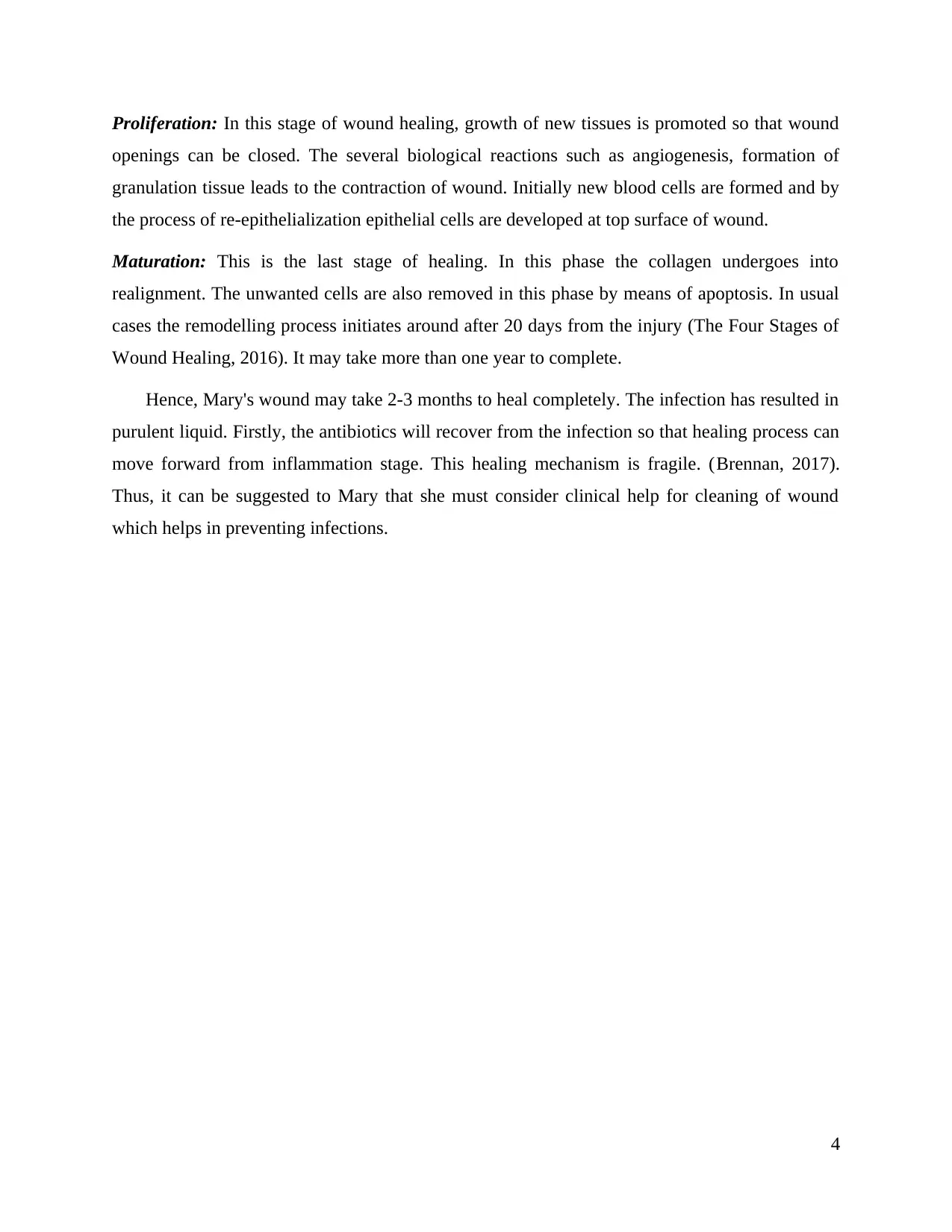
Proliferation: In this stage of wound healing, growth of new tissues is promoted so that wound
openings can be closed. The several biological reactions such as angiogenesis, formation of
granulation tissue leads to the contraction of wound. Initially new blood cells are formed and by
the process of re-epithelialization epithelial cells are developed at top surface of wound.
Maturation: This is the last stage of healing. In this phase the collagen undergoes into
realignment. The unwanted cells are also removed in this phase by means of apoptosis. In usual
cases the remodelling process initiates around after 20 days from the injury (The Four Stages of
Wound Healing, 2016). It may take more than one year to complete.
Hence, Mary's wound may take 2-3 months to heal completely. The infection has resulted in
purulent liquid. Firstly, the antibiotics will recover from the infection so that healing process can
move forward from inflammation stage. This healing mechanism is fragile. (Brennan, 2017).
Thus, it can be suggested to Mary that she must consider clinical help for cleaning of wound
which helps in preventing infections.
4
openings can be closed. The several biological reactions such as angiogenesis, formation of
granulation tissue leads to the contraction of wound. Initially new blood cells are formed and by
the process of re-epithelialization epithelial cells are developed at top surface of wound.
Maturation: This is the last stage of healing. In this phase the collagen undergoes into
realignment. The unwanted cells are also removed in this phase by means of apoptosis. In usual
cases the remodelling process initiates around after 20 days from the injury (The Four Stages of
Wound Healing, 2016). It may take more than one year to complete.
Hence, Mary's wound may take 2-3 months to heal completely. The infection has resulted in
purulent liquid. Firstly, the antibiotics will recover from the infection so that healing process can
move forward from inflammation stage. This healing mechanism is fragile. (Brennan, 2017).
Thus, it can be suggested to Mary that she must consider clinical help for cleaning of wound
which helps in preventing infections.
4
⊘ This is a preview!⊘
Do you want full access?
Subscribe today to unlock all pages.

Trusted by 1+ million students worldwide
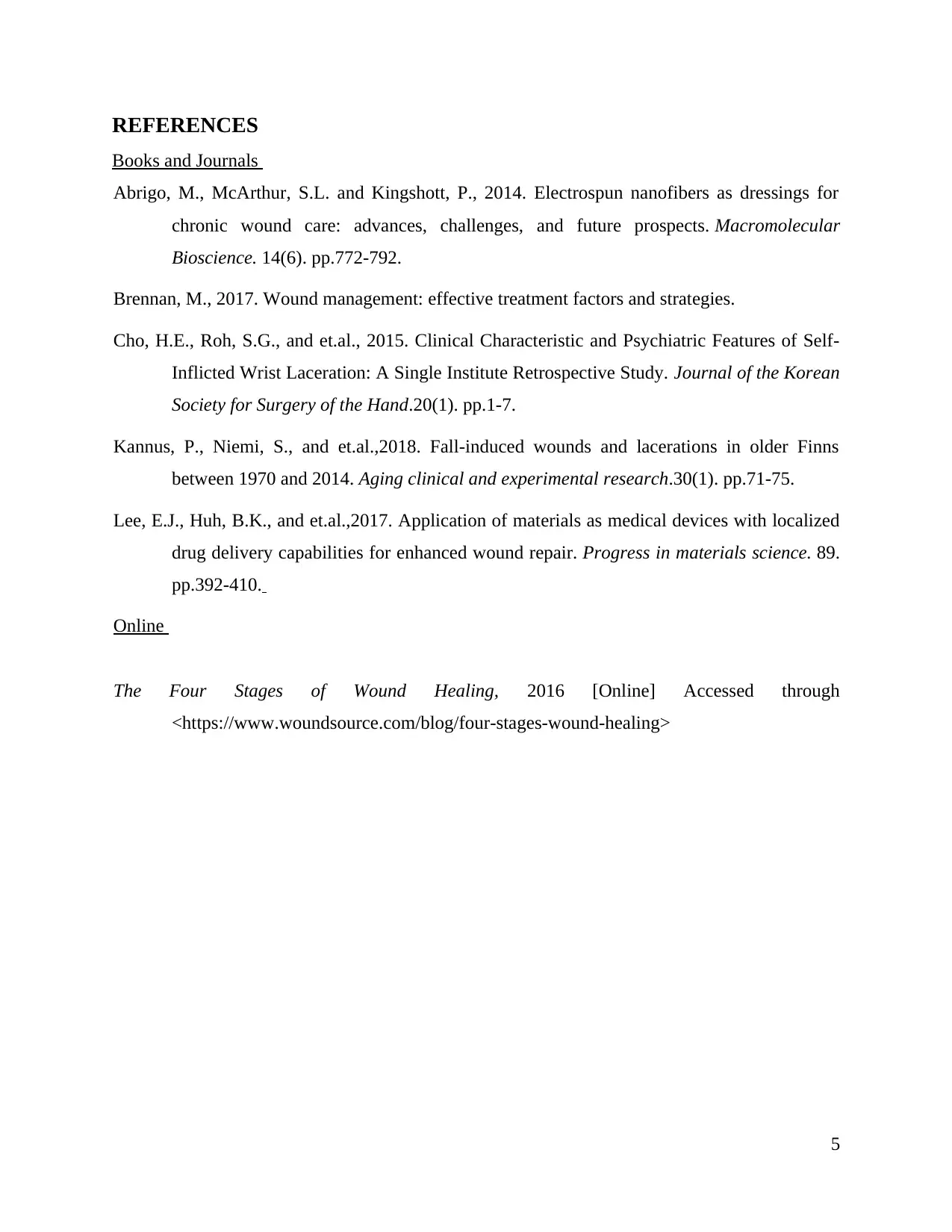
REFERENCES
Books and Journals
Abrigo, M., McArthur, S.L. and Kingshott, P., 2014. Electrospun nanofibers as dressings for
chronic wound care: advances, challenges, and future prospects. Macromolecular
Bioscience. 14(6). pp.772-792.
Brennan, M., 2017. Wound management: effective treatment factors and strategies.
Cho, H.E., Roh, S.G., and et.al., 2015. Clinical Characteristic and Psychiatric Features of Self-
Inflicted Wrist Laceration: A Single Institute Retrospective Study. Journal of the Korean
Society for Surgery of the Hand.20(1). pp.1-7.
Kannus, P., Niemi, S., and et.al.,2018. Fall-induced wounds and lacerations in older Finns
between 1970 and 2014. Aging clinical and experimental research.30(1). pp.71-75.
Lee, E.J., Huh, B.K., and et.al.,2017. Application of materials as medical devices with localized
drug delivery capabilities for enhanced wound repair. Progress in materials science. 89.
pp.392-410.
Online
The Four Stages of Wound Healing, 2016 [Online] Accessed through
<https://www.woundsource.com/blog/four-stages-wound-healing>
5
Books and Journals
Abrigo, M., McArthur, S.L. and Kingshott, P., 2014. Electrospun nanofibers as dressings for
chronic wound care: advances, challenges, and future prospects. Macromolecular
Bioscience. 14(6). pp.772-792.
Brennan, M., 2017. Wound management: effective treatment factors and strategies.
Cho, H.E., Roh, S.G., and et.al., 2015. Clinical Characteristic and Psychiatric Features of Self-
Inflicted Wrist Laceration: A Single Institute Retrospective Study. Journal of the Korean
Society for Surgery of the Hand.20(1). pp.1-7.
Kannus, P., Niemi, S., and et.al.,2018. Fall-induced wounds and lacerations in older Finns
between 1970 and 2014. Aging clinical and experimental research.30(1). pp.71-75.
Lee, E.J., Huh, B.K., and et.al.,2017. Application of materials as medical devices with localized
drug delivery capabilities for enhanced wound repair. Progress in materials science. 89.
pp.392-410.
Online
The Four Stages of Wound Healing, 2016 [Online] Accessed through
<https://www.woundsource.com/blog/four-stages-wound-healing>
5
1 out of 7
Related Documents
Your All-in-One AI-Powered Toolkit for Academic Success.
+13062052269
info@desklib.com
Available 24*7 on WhatsApp / Email
![[object Object]](/_next/static/media/star-bottom.7253800d.svg)
Unlock your academic potential
Copyright © 2020–2025 A2Z Services. All Rights Reserved. Developed and managed by ZUCOL.


